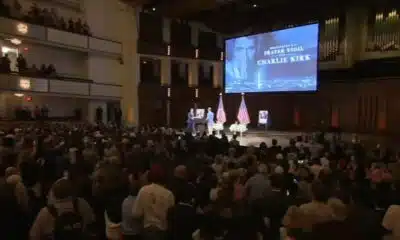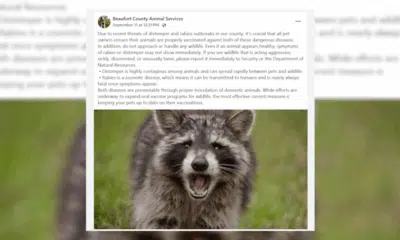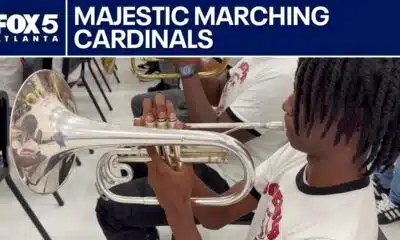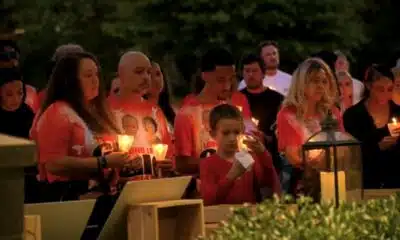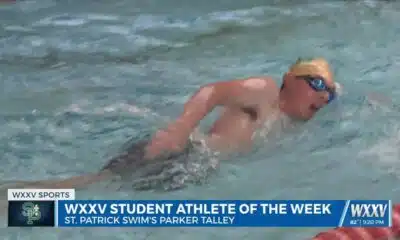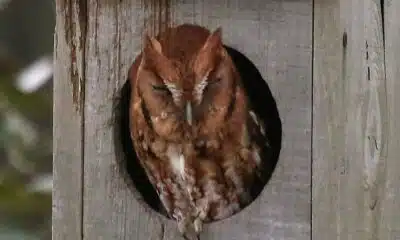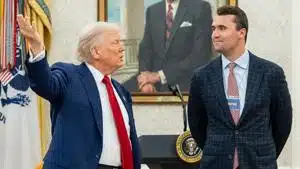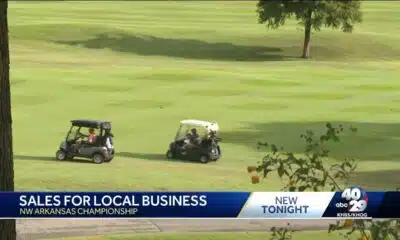News from the South - Virginia News Feed
The Democratic Party of Va. will pick a new leader this month. Here are the candidates’ platforms.
The Democratic Party of Va. will pick a new leader this month. Here are the candidates’ platforms.
by Charlotte Rene Woods, Virginia Mercury
March 11, 2025
Ahead of this year’s gubernatorial and House of Delegates elections, the Democratic Party of Virginia will elect a new leader to be its face and voice at a meeting on March 22.
Unlike the legislative and executive elections this year where candidates will traverse the state or certain districts to plead their case to the masses, DPVA chair hopefuls have a few weeks to convince their colleagues they’re right for the job in this intra-party contest.
Contenders come from within DPVA committees and include a state senator.
When longtime DPVA Chair Susan Swecker announced she was stepping down last month, Sen. Lamont Bagby, D-Henrico, emerged as an all but shoe-in successor. As the current chair of Virginia’s Legislative Black Caucus, he also chairs the Senate’s transportation committee and serves on various other committees. His bid for DPVA chair came with a long list of endorsements from prominent Democratic leadership in Virginia to include Democratic gubernatorial candidate Abigail Spanberger.
Then activist and organizer Josh Stanfield entered the race, along with DPVA steering committee member and 10th Congressional District Chair Zach Pruckowski. Both are running on a platform of “empowering” other members of the party organizing apparatus and exploring the potential for the DPVA chairperson to be a full-time position.
Each man is currently making their case to their counterparts in the DPVA apparatus ahead of their election later this month.
With the House of Delegates up for election this year, Democrats will need to keep a majority to advance constitutional amendments that would enshrine voting, reproductive and marriage equality rights into Virginia’s constitution. DPVA also has a role to play in supporting gubernatorial, lieutenant governor and attorney general candidates this year.
Who’s who in this race?
As the co-founder and executive director of Activate Virginia, Stanfield is no stranger to political organizing or public engagement. The organization has worked to recruit candidates to run for office and has advocated for not accepting money from Virginia’s utility monopolies, which have heavily funded lawmakers and successfully lobbied for legislation that benefited them for years.
Key changes he would make to DPVA if he were to lead it would be “empowering” the organization’s central committee to deliberate the organization’s decisions and to move towards the DPVA chair being a full-time position.
Stanfield called Swecker’s decade in the role a “bridge” towards this reform. While the position is elected every four years, the chair hasn’t been seen as someone who is dedicating a 40-hour workweek to it the way that Swecker has appeared to have done. Under her leadership, paid staff of the party has grown.
As she is stepping down, Stanfield and his opponents have the chance to helm DPVA through the end of this year before the election for the next four-year term happens in 2026.
Pruckowski shares the goal of more robust communication with central committee members. Pruckowski has been involved with DPVA for over a decade. While Northern Virginia has been reliably Democratic for decades, Republicans have been working to gain ground in the area — making Democrats need to work harder to keep their turf.
His years of experience within DPVA and as a regional chair within it is what makes him best suited to take the helm this year, Pruckowski said. He said the party could work towards shifting the overall chair of the party to a full-time position when the elections for its next full four-year term occur next year.
Bagby, on the other hand, would add DPVA chair work to his resume of responsibilities in various leadership roles. He said he does not plan to step down from his position as a state senator or from the committees he serves on and the one that he chairs, but he would step back from leading the Black caucus. With 32 members, the caucus is ripe with others who could step into the role as its face and primary voice.
Bagby cites his caucus leadership role as a key experience that prepares him to lead DPVA if elected. Having served in the House of Delegates and now in the Senate too, Bagby said he’s had a track record of working with others and helping to support fellow Democrats around the state.
Some of the Democratic leaders he’s built relationships with are backing him now, like U.S. Sen. Tim Kaine (who was DPVA chair while serving as governor), current Democratic leadership in the Virginia House of Delegates and Senate, as well as gubernatorial candidate Abigail Spanberger. He’s not just relying on the big names to secure a win, though.
“I appreciate the endorsements I’ve had, but the work is really going to be from those rank and file members of the committee,” Bagby said. “I’m excited to continue to do what I think I’ve done well, and that is keep people in the room and keep folks coordinated … and keeping the overall goal in mind — getting Democrats elected.”
‘Empowering’ more party members
Having served other roles in DPVA already, Bagby’s opponents have some ideas for reform and each spoke with The Mercury about how they could “empower” other party members.
Stanfield, who has served on the central committee at various points over the years, said he felt those committee members were not able to weigh in on party-wide decisions as much as others.
“It’s this sort of idea of actually empowering members of the central committee to have a say, which means more regular voting on a larger range of issues,” Stanfield said.
Pruckowski noted how DPVA’s overall apparatus includes hundreds of people who volunteer their time around the state that he feels are “under-utilized and under-listened to.”
While there are roughly 300 people involved in DPVA representing different coalitions of the group around the state, while the steering committee is what “governs all party matters,” according to DPVA’s website. That committee is composed of the chair, vice-chair, secretary, treasurer, Democratic National Committee members and chairs that represent Virginia’s congressional districts.
Fielding more input is something that Pruckowski said he’s pushed for several years. He also currently serves on the party’s steering committee as its 10th Congressional District Chair.
In his time being involved with DPVA, Stanfield described feeling like many decisions were made by the steering committee for others to “rubber stamp.”
“I mean, it’s sort of understood procedurally ‘you’re just going to approve this,’” he explained.
Meanwhile, Pruckowski said that he’d like DPVA’s leadership to field input from the regional members, particularly when it comes to strategizing elections.
“I think that the folks who know best about what we need to do to win in an area are the volunteer leaders in that area,” he said.
Stanfield questions a potential Bagby conflict of interest, liability for the party
As the next DPVA chair will be a face and voice for the Democratic Party in the state, Stanfield cautions how a potential conflict of interest might be something Republicans could target Bagby for.
He pointed to reporting from independent journalist Christa Motley. Her exploration into how recovery homes are funded revealed potential conflicts of interest between Bagby and the organization that receives state funding for recovery houses.
Motley’s reporting detailed how state funding to the Virginia Association of Recovery Residences drastically increased in recent years after Bagby’s legislative advocacy. Emails she obtained through a Freedom of Information Act request show VARR officials praising Bagby numerous times and calling him a “champion.”
Motley also reported that a limited liability company had been formed between Bagby, VARR leaders and others that later leased office space in Richmond and how a for-profit recovery house owned by Bagby’s brother was also a recipient of funding allocated from VARR.
When Motley asked Bagby about potential for conflicts of interest, he described himself as a sideline advocate for VARR.
But Stanfield felt it was worth further exploration and something Bagby should elaborate on if he’s to become DPVA chair. In a call with The Mercury, Stanfield said he wanted to give Bagby “a chance to tell us what’s going on here — it’s kind of a liability right?”
But Bagby disagrees and said in a phone interview “All I have done was give money to the recovery community.”
He did not want to speak on record further about the matter.
How DPVA could boost rural Democrats
Historically, Democrats have not held much elected ground in the rural parts of Southwest and Southside Virginia. Republicans and conservative-leaning voters tend to dominate these areas. So, financial investments in rural Democrats could be argued as a waste of resources on unwinnable seats but also as an investment in the party’s future bases.
A potential case for investment was made in 2023 when Lily Franklin narrowly lost to Del. Chris Obenshain in the 41st House of Delegates district by 183 votes.
Their contest saw more than $1.5 million in spending and the two are slated for a rematch this year. DPVA was Franklin’s top donor.
This year it could again be a seat that DPVA considers boosting financially and one that Stanfield, Bagby or Pruckowski might want to stump in.
“If there’s a candidate out in Southwest Virginia in Bath County or Lee County, that’s helping the top of the ticket as well,” Bagby said. “So us investing in them is also investing in the top of the ticket.”
While the House Democratic Caucus will be expected to boost candidates this year, their focus is typically on the battleground districts — usually in Hampton Roads, the Richmond area and Northern Virginia. Perhaps rural contests are where DPVA could also lend ground support or financial boons.
“I think that thing we’ve struggled with as a party is, you know, listening to all the activists on the ground all across the state,” Pruckowski said.
It’s why he also hopes DPVA can focus some of its candidate training resources to rural campaigns as well.
Stanfield also sees ways DPVA can help foster some rural-focused fundraising that doesn’t necessarily have to come totally out of DPVA’s coffers.
For instance, he noted how Virginia draws national attention with its House and governor elections the year following a presidential election. This is a chance, he said, to set up a fund and draw on that attention.
“I feel confident people like (U.S. Rep Bernie Sanders, D-Vermont) and (U.S. Rep. Alexandria Ocasio-Cortez, D-New York) and others would share this thing out,” he said.
During the 2018 congressional midterm elections, he worked for 6th Congressional District candidate Jennifer Lewis. Though the seat ultimately went to Republican U.S. Rep. Ben Cline, the campaign secured the endorsement of outgoing Republican Rep. Bob Goodlatte’s son, and sparked a grassroots campaign to raise funds.
With a slim 51-49 lead in Virginia’s House of Delegates, Democrats will try to widen that margin this year, as all 100 seats will be up for election. A potential rebuke to President Donald Trump and his influence over the Republican Party could inspire heightened Democratic turnout in the June primaries or November election this year, but party organizers and candidates alike will still need to put in the groundwork to keep voters engaged.
GET THE MORNING HEADLINES.
Virginia Mercury is part of States Newsroom, a nonprofit news network supported by grants and a coalition of donors as a 501c(3) public charity. Virginia Mercury maintains editorial independence. Contact Editor Samantha Willis for questions: info@virginiamercury.com.
The post The Democratic Party of Va. will pick a new leader this month. Here are the candidates’ platforms. appeared first on virginiamercury.com
News from the South - Virginia News Feed
Some employers take action against employees for social media comments on Charlie Kirk's death
SUMMARY: Following Charlie Kirk’s death, some Virginia employers have taken action against employees who made controversial social media comments. In healthcare and education sectors, individuals were placed on leave or terminated for remarks deemed unprofessional or supportive of violence. Riverside Walter Reed Hospital fired an anesthesiologist, and Newport News and Accomack County schools disciplined staff members. Experts highlight the blurred line between personal expression and professional conduct due to social media’s reach. William and Mary law professor Margaret Hugh emphasized that employment laws and at-will policies allow employers broad authority to act. She urges unity and respect amid heightened tensions.
Some Virginia employers are taking action against employees for social media comments made regarding Charlie Kirk’s death. A legal expert weighed in on where the line is drawn.
Subscribe: https://www.youtube.com/user/wvectv/?sub_confirmation=1
Download the 13News Now app: https://bit.ly/13NewsNowApp
Watch 13News Now+ for free on streaming: https://www.13newsnow.com/13NewsNowPlus
Check out our website: https://www.13newsnow.com/
Like us on Facebook: https://www.facebook.com/13newsnow/
Follow us on X/Twitter: https://x.com/13newsnow
Follow us on Instagram: https://www.instagram.com/13newsnow/
News from the South - Virginia News Feed
Area of interest forms in the Atlantic
SUMMARY: On September 11, 2025, Chief Meteorologist Tim Pandages reported on Hurricane Hub Live about tropical developments in the Atlantic and eastern Pacific. In the Atlantic, a low-chance area of interest near the Cabo Verde Islands may become Tropical Storm Gabrielle but requires favorable conditions. Recent tropical waves have struggled due to stable atmospheric conditions. Models show possible development east of the Leeward Islands with a likely recurving path away from Bermuda. In the eastern Pacific, Tropical Depression 13E has formed, expected to become Hurricane Mario, the season’s 8th hurricane. The Atlantic has had only one hurricane so far, Major Hurricane Aaron. Activity is expected to increase into October.
The newly formed area of interest could become Invest 92-L off the coast of Africa. Find out about that and more during tonight’s episode of Hurricane Hub LIVE! Livestream from Thursday, September 11, 2025.
Subscribe: https://www.youtube.com/user/wvectv/?sub_confirmation=1
Download the 13News Now app: https://bit.ly/13NewsNowApp
Watch 13News Now+ for free on streaming: https://www.13newsnow.com/13NewsNowPlus
Check out our website: https://www.13newsnow.com/
Like us on Facebook: https://www.facebook.com/13newsnow/
Follow us on X/Twitter: https://x.com/13newsnow
Follow us on Instagram: https://www.instagram.com/13newsnow/
News from the South - Virginia News Feed
Cat cafes, chromotherapy and pumpkin delivery: Here’s what’s new in RVA this September
SUMMARY: This September in RVA, Patch to Porch RVA delivers handpicked pumpkins from local farms, offering design, setup, and cleanup services for homes and events in Richmond, Henrico, and Chesterfield. Shore Pump introduces Beam Light Sauna, featuring infrared sauna and chromotherapy, promoting detox, skin renewal, and wellness with customizable sessions and memberships. The Fan now hosts River City’s first cat café, The Perfect Bean, combining a coffee bar with an adoptable cat lounge upstairs. Sourced locally, their drinks include seasonal, cat-themed specials. Cats come from Purring Hearts VA rescue, offering adoption opportunities, fostering community engagement and animal welfare.
What’s New in RVA is dedicated to informing you about the latest happenings in the Richmond area.
-
News from the South - North Carolina News Feed6 days ago
What we know about Charlie Kirk shooting suspect, how he was caught
-
Local News7 days ago
Russian drone incursion in Poland prompts NATO leaders to take stock of bigger threats
-
News from the South - North Carolina News Feed6 days ago
Federal hate crime charge sought in Charlotte stabbing | North Carolina
-
Local News Video7 days ago
Introducing our WXXV Student Athlete of the Week, St. Patrick’s Parker Talley!
-
The Center Square7 days ago
Weapon recovered as manhunt continues in Kirk assassination investigation | National
-
Our Mississippi Home5 days ago
Screech Owls – Small but Cute
-
News from the South - Tennessee News Feed7 days ago
Middle Tennessee State University dean filed over Kirk comments | Tennessee
-
News from the South - Arkansas News Feed6 days ago
NW Arkansas Championship expected to bring money to Rogers





